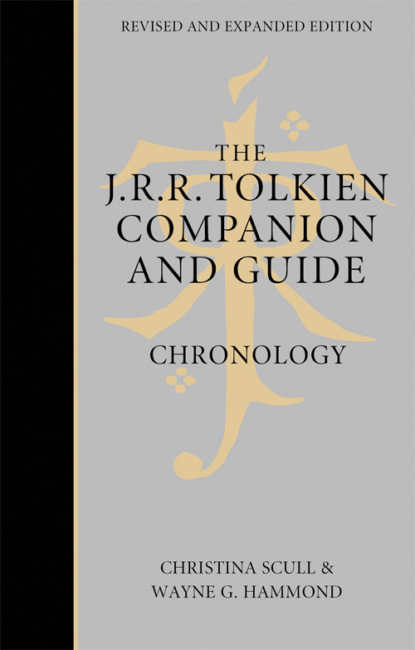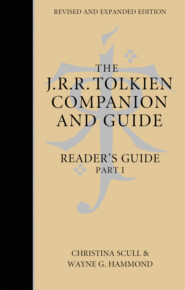По всем вопросам обращайтесь на: info@litportal.ru
(©) 2003-2024.
✖
The J. R. R. Tolkien Companion and Guide: Volume 1: Chronology
Настройки чтения
Размер шрифта
Высота строк
Поля
15 April 1917 (postmark) Wiseman writes to Tolkien at 95 Valley Drive, Harrogate, confirming what he has already telegraphed, that he is on leave and wants to visit Tolkien and Edith in the morning of 18 April. According to his present orders, he needs to catch a train from Leeds in the afternoon, but if his leave is extended he might not come until 19 April. On receiving this, Tolkien probably telegraphs that he has to report for duty on the latter date.
17–?18 April 1917 In the circumstances, Wiseman arrives in Harrogate on 17 April, at 6.51 p.m. according to a telegram he sends that afternoon. Tolkien lends him manuscripts of Smith’s poems and a typewritten copy.
19 April 1917 At the expiration of his leave Tolkien joins the 3rd (Reserve) Battalion of the Lancashire Fusiliers at Thirtle Bridge Camp on the Holderness peninsula, near Withernsea, part of the Humber Garrison. The battalion has two duties: to train new recruits for the front, and to guard against any assault from the sea. The camp houses some 1,600 soldiers. See note.
1 May 1917 Tolkien is examined by a Medical Board at Humber Garrison headquarters in Hull. ‘He is improving but requires hardening’ (Public Record Office). The Board declares him fit for home service but unfit for general service. His address is recorded as HQ3, Thirtle Bridge.
May 1917 Tolkien spends part of his time at the Musketry Camp near Hornsea, established by the Army to refresh regimental officers and non-commissioned officers in the use of the rifle in battle.
5 May 1917 By this date, Edith and Jennie are resident in Hornsea, at 1 Bank Terrace.
19 May 1917 Wiseman writes to Tolkien, returning the manuscripts of Smith’s poems. He will keep the typed copy until he can send Tolkien his suggestions. He thinks that they should not aim at publishing ‘Opera Omnia, but a good book of verse’ (Tolkien Papers, Bodleian Library, Oxford).
1 June 1917 Tolkien is examined by a Medical Board at Humber Garrison headquarters in Hull. The Board declares him fit for general service, and orders him to remain with his unit at Thirtle Bridge until further notice.
?Early June 1917 For a brief time early in Tolkien’s posting to the Humber Garrison he is put in charge of an outpost and given quarters which allow Edith to live with him for a while. See note. – Tolkien will annotate a later version of his poem Sea-Song of an Elder Day (after 31 August–2 September 1917, see below): ‘Present shape due to rewriting and adding introd[uction] & ending in a lonely house near Roos, Holderness (Thirtle Bridge Camp) Spring 1917’ (quoted in *The Shaping of Middle-earth (1986), p. 215). The ‘lonely house’ is probably to be identified with the officer’s quarters provided to Tolkien as commander of the outpost. The extant manuscript of the poem as written out in March 1915 (as Sea-Chant of an Elder Day) includes a later addition, a short prose introduction which connects the poem to the story of the fall of Gondolin (see entry for End of 1916–early 1917): it becomes ‘the song that Tuor told to Eärendel his son what time the Exiles of Gondolin dwelt awhile in Dor Tathrin the Land of Willows after the burning of their city’ (quoted in The Shaping of Middle-earth, p. 214). – Tolkien also continues to work on his Gnomish lexicon, rewriting in ink over an earlier pencil layer. An inscription indicates that this stage at least is written at ‘Tol Withernon’, almost certainly a Gnomish reference to ‘Withernsea’.
Tolkien and Edith visit a wood near Roos. There she dances for him, a seminal event in the development of his mythology. As he will describe it in 1964 in a letter to Christopher Bretherton: ‘the original version of the “Tale of Lúthien Tinúviel and Beren” … was founded on a small wood with a great undergrowth of ‘hemlock’ (no doubt many other related plants were also there) near Roos in Holderness, where I was for a while on the Humber Garrison’ (Letters, p. 345); and in a letter to his son Christopher in 1972: I never called Edith Lúthien – but she was the source of the story that in time became the chief part of the Silmarillion. It was first conceived in a small woodland glade filled with hemlocks at Roos in Yorkshire … . In those days her hair was raven, her skin clear, her eyes brighter than you have seen them, and she could sing and dance’ (Letters, p. 420). See note.
Summer 1917 Hilary Tolkien receives minor shrapnel wounds while helping to carry supplies over the Passchendaele Ridge near Ypres.
?Late June–early July 1917 Christopher Wiseman writes to Tolkien and returns the typewritten copies of Smith’s poems, with a suggested arrangement. He is convinced that only a selection of Smith’s best work should be published, and it should be arranged most effectively rather than by strict order of writing. He suggests that some of the poems might be accompanied by explanatory notes of the circumstances in which they were written. He also comments at length on the political situation. He has not heard from Tolkien since he saw him in Harrogate.
?c. 14–21 July 1917 Tolkien is at the Royal Engineers Signal Depot, Dunstable, Bedfordshire, for a signalling examination or, perhaps, a refresher course. See note.
31 July 1917 T.K. Barnsley from King Edward’s School is killed in action in the Third Battle of Ypres.
1 August 1917 Tolkien attends the elaborate dinner with which the 3rd Battalion of the Lancashire Fusiliers celebrates Minden Day. He signs his menu card and obtains the signatures of twenty-three others at the dinner, including L.R. Huxtable. – Tolkien writes a poem, Companions of the Rose, dedicated ‘For RQG [R.Q. Gilson] Suffolk Regiment GBS [G.B. Smith] Lancashire Fusiliers’. On Minden Day, roses are worn by all ranks in the Lancashire Fusiliers, and a toast is drunk to those who fell at Minden. (Gilson’s regiment had also fought in that battle.)
Mid-August 1917 Tolkien is admitted to ‘Brooklands’, an officers’ hospital in Cottingham Road, Hull, by 13 August, and for six weeks runs a fever. He finds congenial company among the other patients, including a friend from the Lancashire Fusiliers, and continues his writing, including The Tale of Tinúviel. – The hospital is visited by nuns of the order of the Sisters of Mercy who have a house in Hull. One of these, Sister Mary Michael, becomes a lifelong correspondent and friend, and godmother to Tolkien’s second son, Michael. See note.
?Mid- to late August or ?September 1917 Tolkien writes a poem, *The Grey Bridge of Tavrobel. At a later date he will write on the manuscript: ‘Brooklands Red [Cross] hosp[ital] Cottingham Road, Hull Sept or Aug 1917?’
Between 21 and 24 August 1917 Unhappy in their lodgings in Yorkshire and unable to visit Tolkien in hospital often because of the difficult journey to Hull, and with Edith now in an advanced state of pregnancy, Edith and Jennie decide to return to Cheltenham until the birth of the child. Their address will be 37 Montpellier Villas, Cheltenham, until 11 September inclusive.
22 August 1917 In the early hours German Zeppelins attack the Yorkshire coast, including the mouth of the Humber, with high-explosive and incendiary bombs.
31 August–2 September 1917 Tolkien again rewrites his poem Sea-Song of an Elder Day, now with an added title, The Horns of Ulmo (> The Horns of Ylmir), to fit it explicitly within his mythology. He writes on the manuscript ‘Aug[ust] 31 Sep[tember] 2 1917 Hospital Hull’. Later he will write out a fair copy of the poem, incorporating emendations, with the annotation described above (see entry for Spring 1917).
September 1917 Tolkien further revises his poem The Mermaid’s Flute.
1 September, 7 and 10 October 1917 Wiseman replies in stages to a letter by Tolkien, who has heard about the death of Wiseman’s mother. Wiseman apologizes for not sending an earlier letter, and provides details. He has heard from Tolkien that he and Edith are expecting a baby and says it is great news. He agrees with Tolkien’s arrangement of G.B. Smith’s poems for publication. He has heard from Mrs Incledon that Tolkien is still in hospital in Hull. He approves of the poem Companions of the Rose which Tolkien had enclosed with his last letter, and says that he is ‘sorry it is the only one [presumably, the only entirely new poem] this year’. But the Muse ‘has not been entirely idle because you have spent a good time on the mythology’ (Tolkien Papers, Bodleian Library, Oxford). He discusses at length an anonymous leader he has read in the Times Literary Supplement (20 September 1917, pp. 445–6) entitled Creation and Invention, on the distinction between ‘invention’ and ‘imagination’. Wiseman sees the former in Tolkien’s poem Copernicus and Ptolemy and the latter in his mythology.
12 September 1917 By this date, Edith and Jennie move to 6 Royal Well Terrace, Cheltenham. They will lodge there through at least 15 October.
25 September 1917 German Zeppelins attack the Lincolnshire and Yorkshire coasts between midnight and 3 am. Although they are unable to penetrate far inland because of defensive gunfire, they drop sixteen bombs on Hull, with little material damage.
16 October 1917 Tolkien is examined by a Medical Board at Humber Garrison headquarters in Hull. He has been in hospital for nine weeks, and though his temperature returned to normal three weeks ago, he still has not recovered his strength, he suffers from debility and pain in his arms and shins, and he looks delicate. The Board declares him 30 per cent disabled, unfit for general and home service for one month but fit for light duty at home, and orders him to rejoin the 3rd Lancashire Fusiliers at Thirtle Bridge. He leaves the hospital on this date.
30 October 1917 *Walter Rolfe Brown of Exeter College, a member of the Apolausticks and the Chequers Clubbe, is killed in action with the Artists’ Rifles in the Second Battle of Passchendaele (Third Battle of Ypres).
16 November 1917 Tolkien is examined by a Medical Board at Humber Garrison headquarters in Hull. He is slowly recovering, and in the intervening month has suffered only one slight attack of fever. The Board declares him 20 per cent disabled, unfit for general service for two months but fit for home service, including active duty with troops. He is ordered to continue service with the 3rd Lancashire Fusiliers at Thirtle Bridge, but continues to receive hospital treatment. – Edith gives birth to a son in a Cheltenham nursing home. It is a difficult delivery, and for a while her life is in danger. Tolkien cannot get leave for some days, but May Incledon writes to reassure him. At some point he will sell the last of the shares in South African mines he inherited to pay for Edith’s medical care.
Mid-November 1917 Tolkien is transferred to the 9th Battalion, Royal Defence Corps, based at Easington, some ten miles south of Thirtle Bridge near the tip of the Holderness peninsula. He resides, however, a few miles still further south, at Kilnsea, while receiving medical care in Easington. See note.
19 November 1917 R.W. Reynolds writes to thank Tolkien for a parcel and for a poem or poems which he will read aloud to his wife. He is very interested ‘in the book of tales you are at work on’ (The Book of Lost Tales) and hopes to see it ‘when it is in a state to travel’ (Tolkien Papers, Bodleian Library, Oxford). Sidgwick & Jackson have been considering G.B. Smith’s poems for publication for three weeks.
c. 22 November 1917 Tolkien goes to Cheltenham to see Edith and the baby. Father Francis comes from Birmingham. The baby is baptized *John Francis Reuel Tolkien. His godparents are Hilary Tolkien and Mary Incledon (who has become a Roman Catholic). To pay the costs of Edith’s medical care, Tolkien sells the last few shares in South African mines remaining from his inheritance. According to Humphrey Carpenter, after the christening of John Tolkien ‘Edith brought the child back to Yorkshire, moving into furnished rooms at Roos’ (Biography, p. 97). See note.
24 November 1917 Tolkien’s promotion from second lieutenant to full lieutenant as of 1 July 1917 is listed in the London Gazette.
December 1917–March 1918 Tolkien revises part of The Town of Dreams and the City of Present Sorrow (see entry for 10 November–1 December 1916) as The Song of Eriol, referring to the wandering mariner in The Book of Lost Tales. One of the manuscripts of the poem includes a later note, ‘Easington 1917–18’.
?10 (?17 ?20) December 1917 Wiseman replies to a letter in which Tolkien told him of the safe birth of his son. He insists on being considered as an uncle. He has received several letters from Tolkien, in one of which Tolkien asked for more about the article in the Times Literary Supplement (see entry for 1 September 1917). Wiseman now writes at great length what he remembers about it, and replies to Tolkien’s comments on what Wiseman had written in his earlier letter.
24 December 1917 Tolkien’s cousin Lieutenant Thomas Ewart Mitton, a signals officer with the Royal Engineers, dies in an accident while erecting telegraph wires over a railway near Ypres.
1918 (#ulink_24bcfce0-2c1e-593d-b8e7-e83e8a4d5590)
1918 Tolkien probably spends much of his leisure time during 1918 writing the first version of a third story for The Book of Lost Tales: The Tale of Turambar (see *The Book of Lost Tales; *‘Of Túrin Turambar’).
1918–1919 An influenza pandemic kills between twenty and forty million people around the world (including, in 1919, Tolkien’s friend Colin Cullis).
January–March 1918 Tolkien rewrites the poem The Lonely Harebell (first composed in November 1916). On a later manuscript, in which the poem is called Elf Alone, he will add a note: ‘1915–1916 rewr[itten] 1918 | Cromer, Hosp[ital] Birm[ingham] | farmhouse near Easington, Yorks’.
19 January 1918 Tolkien is examined by a Medical Board at Humber Garrison headquarters in Hull. Although he has had two slight attacks, with a temperature reaching 100 degrees Fahrenheit, which required bed rest for five days, he is gradually improving. The Board declares him 20 per cent disabled, unfit for general service for one month but fit for active duty with troops on home service for one month. He is ordered to continue service with the 9th Royal Defence Corps at Easington, and treatment by the regimental medical officer.
19 February 1918 Tolkien is examined by a Medical Board at Humber Garrison headquarters in Hull. He is improving slowly but ‘still looks weak & is unable for much exertion … & requires hardening’ (National Archives, Kew WO 339/34423). The Board declares him 20 per cent disabled, unfit for general service but fit for active duty with troops on home service. He is ordered to continue service with the 9th Royal Defence Corps at Easington and treatment by the regimental medical officer.
Late February–early March 1918 At some time in this period Tolkien returns to the 3rd Lancashire Fusiliers at Thirtle Bridge, and for five days is confined to bed by an attack of influenza.
10 March 1918 In the evening, German Zeppelins attack Hull and Hornsea.
19 March 1918 Tolkien is examined by a Medical Board at Humber Garrison headquarters in Hull. His general tone is improving but he still needs hardening. The Board declares him 20 per cent disabled, unfit for general service but fit for active duty with troops on home service. He is ordered to continue service with the 3rd Lancashire Fusiliers at Thirtle Bridge.
10 April 1918 A Medical Board at Humber Garrison headquarters declares Tolkien recovered and fit for general service.
Spring (?May) 1918 Tolkien is posted again to Penkridge, Rugeley Camp, Staffordshire. Edith, John, and Jennie Grove find rooms in a nearby house at Gipsy Green (*Staffordshire), on the Teddesley Park estate. Tolkien is able to stay with them occasionally. The name of Gipsy Green may be reflected in Fladweth Amrod (Gnomish, ‘Nomad’s Green’), a place in Tol Eressëa associated with Eriol and mentioned in The Book of Lost Tales. See note.
May–June 1918 Tolkien makes some drawings at Gipsy Green (Artist and Illustrator, figs. 22–23). One is a view of the house (Gipsy Green), another a series of vignettes (High Life at Gipsy Green): Edith washing herself, fixing her hair, playing the piano, carrying John in the garden; John in his cot; cats that dance when Edith plays the piano; and Tolkien himself in uniform, riding a bicycle to the camp timed ‘8.25 a.m.’ and ‘8.27 a.m.’, and standing erect at ‘9 a.m.’ Another vignette, labelled ‘The fish we couldn’t get at Swanwicks’, refers to a fishmonger in Stafford. A different sheet includes a portrait of Jennie Grove, a view of Edith from behind, and John in his cot. Probably at about this time Tolkien also draws other views of a garden, and Road near Stafford.
?June 1918 Tolkien is transferred to Brocton Camp.
June or July 1918 The firm of Erskine Macdonald publishes A Spring Harvest by Geoffrey Bache Smith, with a short introductory note by ‘J.R.R.T.’
29 June 1918 Tolkien contracts gastritis at Brocton Camp. By 12 July he will be admitted to ‘Brooklands’ officers’ hospital in Hull. – Although she is once again separated from her husband by a long distance, Edith will stay at Gipsy Green until 24 July. She is happy there, finds looking after the baby tiring, and is still not fully recovered from John’s difficult birth.
17 July 1918 A Medical Board in Hull declares Tolkien unfit in any category for one month. While in hospital he will learn a little Russian and work to improve his Spanish and Italian.








